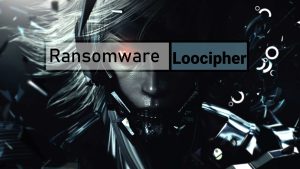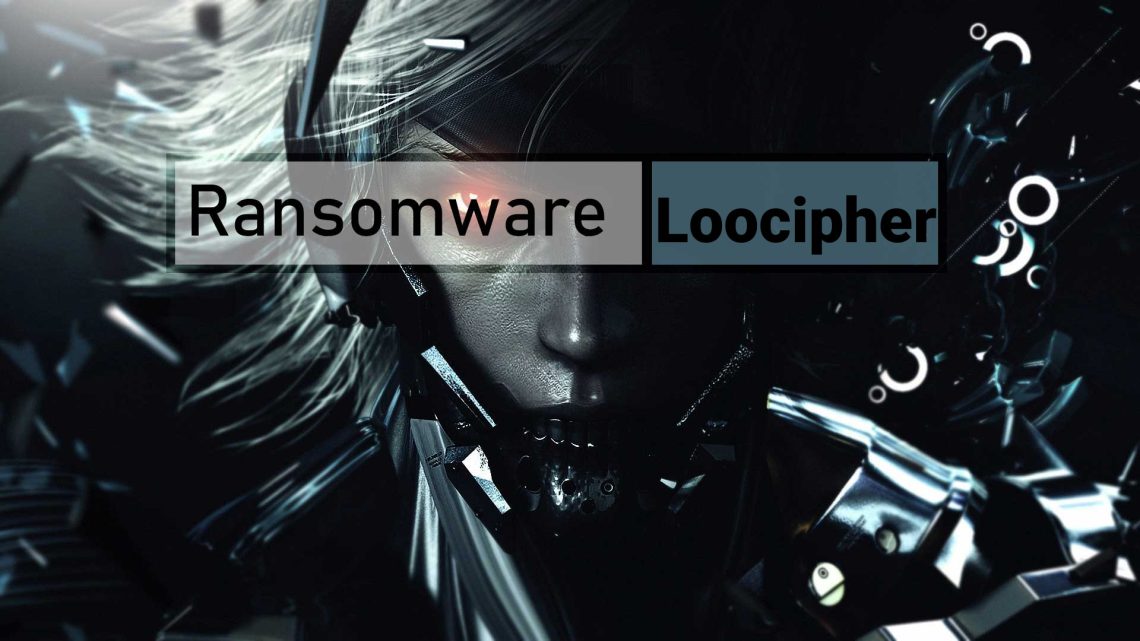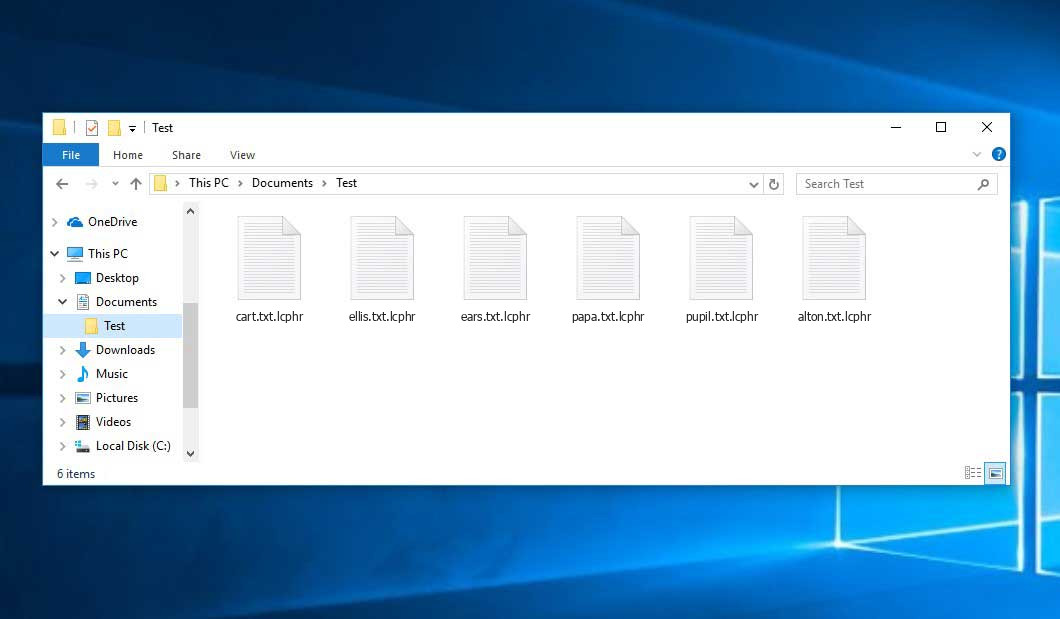The Loocipher virus falls under the ransomware type of malicious agent. Ransomware of such sort encrypts all the data on your PC (photos, text files, excel tables, music, videos, etc) and appends its own extension to every file, creating the @Please_Read_Me.txt text files in each directory which contains the encrypted files.
What is known about the Loociphervirus?
☝️ A strictly correct description for the Loocipher is “a ransomware malicious agent”.
Loocipher appends its extra .lcphr extension to the name of every encoded file. For instance, a file named “photo.jpg” will be turned into “photo.jpg.lcphr”. Just like the Excel sheet with the name “table.xlsx” will end up as “table.xlsx.lcphr”, and so on.
In every directory containing the encoded files, a @Please_Read_Me.txt file will be created. It is a ransom money note. Therein you can find information about the ways of paying the ransom and some other information. The ransom note most probably contains instructions on how to buy the decryption tool from the ransomware developers. That is it.
Loocipher abstract:
| Name | Loocipher Virus |
| Extension | .lcphr |
| Ransomware note | @Please_Read_Me.txt |
| Detection | BScope.TrojanDownloader.Deyma, Mal/Kryptik-BX, Ransom:Win32/StopCrypt.ST!MTB |
| Symptoms | Your files (photos, videos, documents) get a .lcphr extension and you can’t open them. |
| Fix Tool | See If Your System Has Been Affected by Loocipher virus |
In the screenshot below, you can see what a folder with files encrypted by the Loocipher looks like. Each filename has the “.lcphr” extension added to it.
How did my computer get infected with Loocipher ransomware?
There is a huge number of possible ways of ransomware injection.
Nowadays, there are three most popular methods for malefactors to have the Loocipher virus working in your digital environment. These are email spam, Trojan injection and peer-to-peer file transfer.
If you access your mailbox and see letters that look like familiar notifications from utility services companies, postal agencies like FedEx, web-access providers, and whatnot, but whose addresser is unknown to you, be wary of opening those emails. They are most likely to have a harmful item attached to them. Thus it is even riskier to download any attachments that come with emails like these.
Another option for ransom hunters is a Trojan file model1. A Trojan is an object that gets into your machine disguised as something different. For instance, you download an installer for some program you need or an update for some service. However, what is unpacked reveals itself a harmful program that compromises your data. As the update package can have any name and any icon, you’d better be sure that you can trust the source of the stuff you’re downloading. The optimal thing is to trust the software developers’ official websites.
As for the peer file transfer protocols like torrents or eMule, the danger is that they are even more trust-based than the rest of the Web. You can never guess what you download until you get it. Our suggestion is that you use trustworthy websites. Also, it is a good idea to scan the directory containing the downloaded items with the antivirus as soon as the downloading is done.
How to remove the Loocipher virus?
It is crucial to inform you that besides encrypting your data, the Loocipher virus will probably install the Azorult Spyware on your PC to get access to credentials to various accounts (including cryptocurrency wallets). The mentioned spyware2 can derive your logins and passwords from your browser’s auto-filling cardfile.
Often criminals would unblock several of your files to prove that they really have the decryption tool. As Loocipher virus is a relatively new ransomware, security software developers have not yet found a method to undo its work. However, the decoding tools are frequently updated, so the effective countermeasure may soon be available.
Understandably, if the criminals succeed in encoding someone’s essential files, the desperate person will probably fulfill their demands. Nevertheless, paying a ransom does not necessarily mean that you’re getting your blocked information back. It is still risky. After receiving the money, the racketeers may send a wrong decryption key to the injured party. There were reports of hackers simply vanishing after getting the money without even bothering to reply.
The optimal solution against ransomware is to have a system restore point or the copies of your essential files in the cloud storage or at least on an external storage. Obviously, that might be insufficient. Your most crucial thing could be that file you were working on when it all started. But at least it is something. It is also reasonable to scan your drives with the anti-malware utility after the system is rolled back.
Loocipher is not the only ransomware of its kind, since there are other specimens of ransomware out there that act in the same manner. For instance, Oflg, Ofww, Towz, and some others. The two basic differences between them and the Loocipher are the ransom amount and the method of encryption. The rest is the same: files become encoded, their extensions changed, ransom notes appear in each folder containing encrypted files.
Some lucky people were able to decode the blocked files with the aid of the free software provided by anti-ransomware developers. Sometimes the hackers accidentally send the decryption code to the wronged in the ransom readme. Such an epic fail allows the injured part to restore the files. But obviously, one should never rely on such a chance. Make no mistake, ransomware is a criminals’ instrument to lay their hands on the money of their victims.
How do I avoid ransomware injection?
Loocipher ransomware has no endless power, so as any similar malware.
You can protect yourself from ransomware injection within three easy steps:
- Ignore any emails from unknown senders with strange addresses, or with content that has nothing to do with something you are expecting (can you win in a money prize draw without even taking part in it?). If the email subject is more or less something you are waiting for, check all elements of the suspicious letter carefully. A hoax email will always have mistakes.
- Avoid using cracked or unknown software. Trojans are often distributed as a part of cracked products, possibly as a “patch” to prevent the license check. But potentially dangerous programs are very hard to distinguish from trustworthy ones, as trojans sometimes have the functionality you need. Try to find information about this program on the anti-malware message boards, but the optimal way is not to use such software.
- And finally, to be sure about the safety of the files you downloaded, scan them with GridinSoft Anti-Malware. This program will be a perfect armor for your PC.
Reasons why I would recommend GridinSoft3
There is no better way to recognize, remove and prevent ransomware than to use an anti-malware software from GridinSoft4.
Download Removal Tool.
You can download GridinSoft Anti-Malware by clicking the button below:
Run the setup file.
When setup file has finished downloading, double-click on the setup-antimalware-fix.exe file to install GridinSoft Anti-Malware on your PC.

An User Account Control asking you about to allow GridinSoft Anti-Malware to make changes to your device. So, you should click “Yes” to continue with the installation.

Press “Install” button.

Once installed, Anti-Malware will automatically run.

Wait for the Anti-Malware scan to complete.
GridinSoft Anti-Malware will automatically start scanning your PC for Loocipher infections and other malicious programs. This process can take a 20-30 minutes, so I suggest you periodically check on the status of the scan process.

Click on “Clean Now”.
When the scan has finished, you will see the list of infections that GridinSoft Anti-Malware has detected. To remove them click on the “Clean Now” button in right corner.

FAQ
🤔 How can I open “.lcphr” files?Are the “.lcphr” files accessible?
Unfortunately, no. You need to decipher the “.lcphr” files first. Then you will be able to open them.
🤔 The encrypted files are very important to me. How can I decrypt them quickly?
If the “.lcphr” files contain some really important information, then you probably have them backed up. If not, there is still a function of System Restore but it needs a Restore Point to be previously saved. There are other ways to beat ransomware, but they take time.
🤔 You have advised using GridinSoft Anti-Malware to get rid of the Loocipher virus. Does it mean that all my files, currently encrypted, will be removed too?
Absolutely not! Your encrypted files are no threat to your PC.
GridinSoft Anti-Malware only deals with real viruses. The virus that has infiltrated your PC is probably still functional and launching checks periodically to encode any new files you might create on your PC after the attack. As it has been said above, the Loocipher ransomware comes with the company. It installs backdoors and keyloggers that can take your account passwords by trespass and provide hackers with easy access to your system in the future.
🤔 What should I do if the Loocipher malware has blocked my PC and I can’t get the activation code.
If that happened, you need to prepare a flash memory card with a pre-installed Trojan Killer. Use Safe Mode to execute the procedure. The point is that the ransomware starts automatically as the system launches and encodes any new files created or brought into your PC. To block this process – use Safe Mode, which allows only the vital applications to run upon system start. Consider reading our manual on running Windows in Safe Mode.
🤔 And what should I do now?
Many of the encrypted files might still be at your disposal
- If you exchanged your critical files through email, you could still download them from your online mailbox.
- You might have shared photographs or videos with your friends or family members. Just ask them to post those pictures back to you.
- If you have initially got any of your files from the Web, you can try downloading them again.
- Your messengers, social networks pages, and cloud storage might have all those files too.
- Maybe you still have the needed files on your old computer, a notebook, phone, external storage, etc.
HINT: You can use data recovery programs5 to retrieve your lost information since ransomware encodes the copies of your files, deleting the original ones. In the video below, you can learn how to use PhotoRec for such a restoration, but be advised: you won’t be able to do it before you kill the ransomware itself with an antivirus program.
Also, you can contact the following official fraud and scam sites to report this attack:
- In the United States: On Guard Online;
- In Canada: Canadian Anti-Fraud Centre;
- In the United Kingdom: Action Fraud;
- In Australia: SCAMwatch;
- In New Zealand: Consumer Affairs Scams;
- In France: Agence nationale de la sécurité des systèmes d’information;
- In Germany: Bundesamt für Sicherheit in der Informationstechnik;
- In Ireland: An Garda Síochána;
To report the attack, you can contact local executive boards. For instance, if you live in USA, you can have a talk with FBI Local field office, IC3 or Secret Service.
I need your help to share this article.
It is your turn to help other people. I have written this article to help people like you. You can use the buttons below to share this on your favorite social media Facebook, Twitter, or Reddit.
Brendan SmithHow to Remove LOOCIPHER Ransomware & Recover PC

Name: LOOCIPHER Virus
Description: LOOCIPHER Virus is a ransomware-type infections. This virus encrypts important personal files (video, photos, documents). The encrypted files can be tracked by a specific .lcphr extension. So, you can't use them at all.
Operating System: Windows
Application Category: Virus
User Review
( votes)References
- You can read more on Trojans, their use and types in the Trojan-dedicated section of GridinSoft official website.
- You can read more on spyware variants and nature in the respective section of GridinSoft official website.
- GridinSoft Anti-Malware Review from HowToFix site: https://howtofix.guide/gridinsoft-anti-malware/
- More information about GridinSoft products: https://gridinsoft.com/comparison
- Here are Top 10 Data Recovery Software Of 2023.



